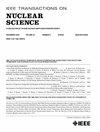基于AlN极化调节机制的p-GaN HEMT辐照硬化研究
IF 1.9
3区 工程技术
Q3 ENGINEERING, ELECTRICAL & ELECTRONIC
引用次数: 0
摘要
本文提出了一种基于AlN极化效应的辐照硬化p-GaN高电子迁移率晶体管(HEMT)。首先,在辐照前,AlN极化效应有助于栅极调节通道,增强GaN层中的电荷共享,抑制漏致势垒降低(DIBL)效应。其次,用AlN应变层钝化栅极蚀刻表面后,AlGaN/GaN界面处的电子阱密度从$7.69\ × 10^{17}$ /(eV $\cdot $ cm2)降至$8.66\ × 10^{17}$ /(eV $\cdot $ cm2)。p-GaN/AlGaN界面的空穴阱密度从$3.0\times 10^{17}$ /(eV $\cdot $ cm2)下降到$5.21\times 10^{17}$ /(eV $\cdot $ cm2),阱能级从0.289 eV下降到0.281 eV。在300和500 krad(Si)的导态辐照下,栅极肖特基势垒和a - hemt的理想因子的降解程度较低。此外,提出了辐照后A-HEMT栅极堆的载流子输运模型。第三,通过器件漂移区AlN极化调制的优化电场可以有效屏蔽导态辐照产生的电荷。在500 krad(Si)剂量后,a - hemt具有较小的${V}_{\text {th}}$漂移和较小的${R}_{\text {dson}}$变化。A-HEMT的通道电场约为常规HEMT (C-HEMT)的1.6倍。电容测量结果表明,AlN应变层可以减少器件有源区导态辐照引起的陷阱。因此,AlN应变层是一种可行的辐照硬化方法。本文章由计算机程序翻译,如有差异,请以英文原文为准。
Irradiation Hardening of p-GaN HEMT Based on AlN Polarization Regulation Mechanism
In this article, an irradiation-hardened p-GaN high electron mobility transistor (HEMT) based on the AlN polarization effect (A-HEMT) was proposed. First, before irradiation, the AlN polarization effect assists the gate in regulating the channel, enhances the charge sharing in the GaN layer, and suppresses the drain-induced barrier lowering (DIBL) effect. Second, after passivating the gate etched surface with the AlN strain layer, the electron trap density at the AlGaN/GaN interface decreased from $7.69\times 10^{18}$ to $8.66\times 10^{17}$ /(eV $\cdot $ cm2). The hole trap density at the p-GaN/AlGaN interface decreased from $3.0\times 10^{18}$ to $5.21\times 10^{17}$ /(eV $\cdot $ cm2), and the trap energy level became shallower from 0.289 to 0.281 eV. As a result of the mitigated gate trap effect, after 300 and 500 krad(Si) on-state irradiation, the gate Schottky barrier and the ideality factor of A-HEMT were less degraded. Furthermore, the post-irradiation carrier transport model of the A-HEMT gate-stack was proposed. Third, the optimized electric field modulated by AlN polarization in the device drift region can effectively shield the charge generated by the on-state irradiation. After a 500 krad(Si) dose, the A-HEMT has a smaller ${V}_{\text {th}}$ drift and a smaller ${R}_{\text {dson}}$ variation. The channel electric field in the A-HEMT was about 1.6 times lower than that of the conventional HEMT (C-HEMT). The measured capacitance showed that the AlN strain layer can reduce the traps induced by on-state irradiation in the active region of the device. Therefore, the AlN strain layer is a feasible irradiation hardening method.
求助全文
通过发布文献求助,成功后即可免费获取论文全文。
去求助
来源期刊

IEEE Transactions on Nuclear Science
工程技术-工程:电子与电气
CiteScore
3.70
自引率
27.80%
发文量
314
审稿时长
6.2 months
期刊介绍:
The IEEE Transactions on Nuclear Science is a publication of the IEEE Nuclear and Plasma Sciences Society. It is viewed as the primary source of technical information in many of the areas it covers. As judged by JCR impact factor, TNS consistently ranks in the top five journals in the category of Nuclear Science & Technology. It has one of the higher immediacy indices, indicating that the information it publishes is viewed as timely, and has a relatively long citation half-life, indicating that the published information also is viewed as valuable for a number of years.
The IEEE Transactions on Nuclear Science is published bimonthly. Its scope includes all aspects of the theory and application of nuclear science and engineering. It focuses on instrumentation for the detection and measurement of ionizing radiation; particle accelerators and their controls; nuclear medicine and its application; effects of radiation on materials, components, and systems; reactor instrumentation and controls; and measurement of radiation in space.
 求助内容:
求助内容: 应助结果提醒方式:
应助结果提醒方式:


